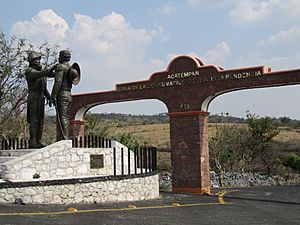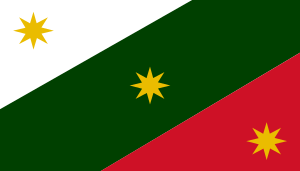Embrace of Acatempan facts for kids
The Embrace of Acatempan (in Spanish: Abrazo de Acatempan) was a very important event in Mexican history. It happened on February 10, 1821. Two key leaders met: Agustín de Iturbide, who led the Spanish army in southern New Spain, and Vicente Guerrero, who was a leader fighting for Mexico's independence. This meeting is often seen as the moment when the two sides, who had been fighting, decided to make peace. It paved the way for Mexico to become an independent nation.
Contents
How It All Started
In 1816, a new viceroy, Juan José Ruiz de Apodaca, came to New Spain. A viceroy was like a governor sent by the King of Spain. He continued a policy of offering pardons to rebel leaders if they stopped fighting. Many important rebel leaders accepted this offer.
However, some leaders, like Guerrero, Pedro Moreno, and Guadalupe Victoria, refused to give up. Because of this pardon policy, the fighting for independence slowed down a lot. Many rebels were killed, captured, or pardoned. This made many people think that New Spain was becoming peaceful again.
Then, on January 1, 1820, something big happened in Spain. A Spanish colonel named Rafael del Riego started a rebellion. He wanted the King, Ferdinand VII, to follow the Constitution of Cadiz. This constitution had been created in 1812. Soon, officials in Mexico also announced that they would follow this constitution. The viceroy in Mexico City did the same on May 31.
This news surprised many people in New Spain. Some worried that the special rights of the church and the army would be taken away.
Guerrero and Iturbide Meet
When Guerrero heard about the changes, he tried to get a Spanish commander named José Gabriel de Armijo to join his side. But Armijo stayed loyal to Spain. Guerrero sent him a letter on August 17, trying again to convince him.
Later, on November 9, Armijo resigned from his position. He said it was for health reasons, but he also had disagreements with Viceroy Apodaca. Apodaca then chose Agustín de Iturbide to lead the army in the south. On November 16, 1820, Iturbide left Mexico City. He set up his base in Teloloapan, which is now in the state of Guerrero.
Iturbide first tried to get Guerrero to accept a pardon, just like Armijo had done. But Guerrero refused. So, Iturbide wrote another letter to Guerrero on January 10. He asked Guerrero to stop fighting and promised that the government would respect his military rank and pardon him. Guerrero still said no.
A few days later, on January 25, Iturbide asked to meet Guerrero. He wanted to share his plan for Mexico's future. This plan later became known as the Plan of Iguala.
The Famous Embrace
The first person to talk about a meeting was a soldier named Tomás Cajigal. He said that Iturbide had joined Guerrero's side. According to him, the meeting happened on March 14.
A historian named Carlos María de Bustamante also said that Guerrero and Iturbide met. But he didn't give a date. He quoted a letter from Iturbide to the viceroy, dated February 18, 1821. In this letter, Iturbide said he couldn't get Guerrero to trust him enough to meet directly. So, they sent someone Guerrero trusted, named Don José Figueroa, to talk instead. This letter suggests that the two leaders might not have met in person before February 18.
Years later, another writer, Lorenzo de Zavala, wrote that the meeting did happen. He even imagined a conversation between them. This is the story that many people remember today:
- Iturbide supposedly told Guerrero: "I am so happy to meet a patriot who has fought for independence and kept the spirit of freedom alive!"
- Guerrero supposedly replied: "I congratulate my country for getting back a son whose bravery and knowledge have been so important!"
However, historian Lucas Alamán disagreed with Zavala's story. He looked at Iturbide's original reports and other sources. He believed that the rebel who met Iturbide in Teloloapan was actually José Figueroa. Figueroa was given permission by Guerrero to discuss all the conditions.
Even with these different stories, the tradition of the "Embrace of Acatempan" is very important in Acatempan, Guerrero. It represents a strong sense of local identity and pride.
What Happened Next
On February 24, Iturbide announced the Plan of Iguala. This plan was supported by Guerrero's troops and other rebel leaders. Many former rebels who had been pardoned decided to fight again to support Iturbide's plan.
Finally, on September 27, the Army of the Three Guarantees, led by Iturbide, marched into Mexico City in triumph. This marked the end of the war and the beginning of Mexico's independence.
See also
 In Spanish: Abrazo de Acatempan para niños
In Spanish: Abrazo de Acatempan para niños
- Plan of Iguala
- Army of the Three Guarantees



